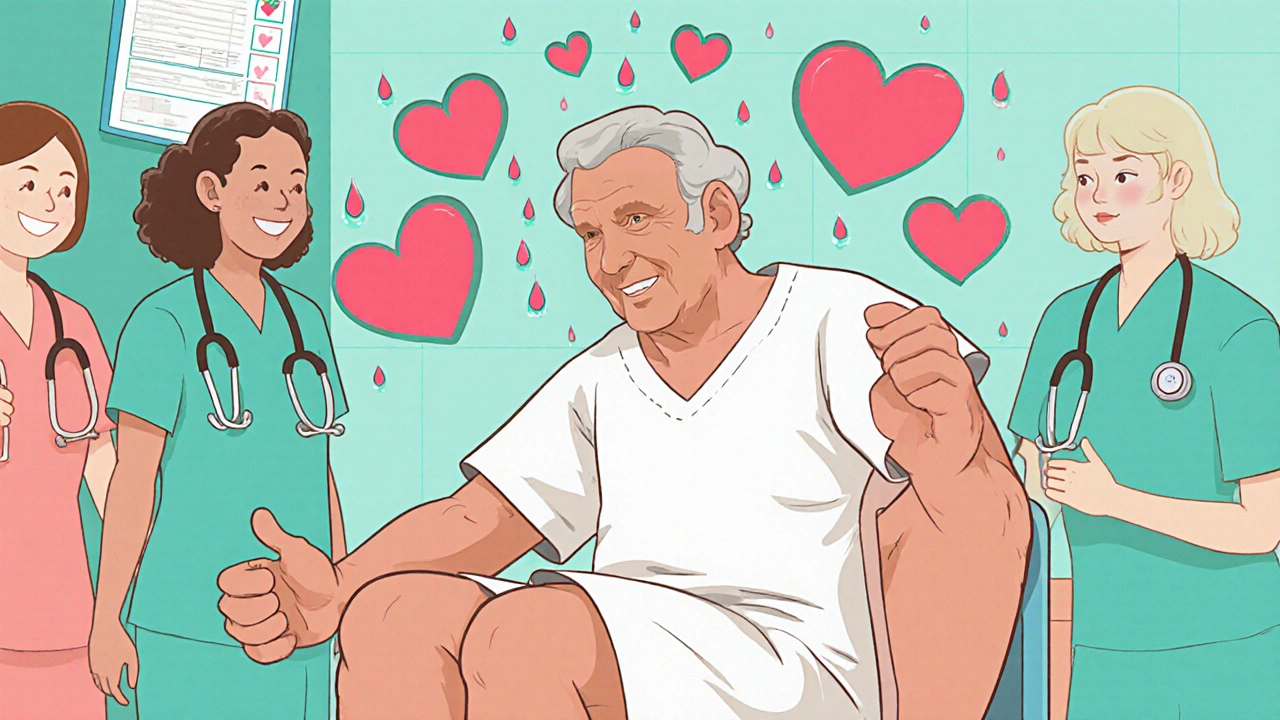 Nov, 25 2025
Nov, 25 2025
After a heart attack, bypass surgery, or other major cardiac event, the last thing you want to do is sit still. But jumping back into your old routine? That’s dangerous. The truth is, exercise isn’t just okay after a heart event-it’s one of the most powerful tools you have to live longer, feel better, and avoid another crisis. The catch? It has to be done right. Too little, and you miss out on recovery. Too much, too soon, and you risk serious harm.
Why Exercise After a Heart Event Isn’t Optional
It’s not hype. Studies show people who complete a formal cardiac rehab program cut their risk of dying within five years by 30%. That’s not a small number. It’s life-changing. And it’s not just about living longer-it’s about living better. People who stick with safe, guided exercise report less fatigue, better sleep, and less anxiety about physical activity. They can play with their grandkids, walk to the store without stopping, and sleep through the night without worrying their heart will give out.
Cardiac rehab isn’t just walking on a treadmill. It’s a full system: monitored exercise, education on diet and meds, and mental health support. The American Heart Association gives it the highest rating possible-Level A-because the evidence is overwhelming. Yet, only 20 to 30% of eligible patients actually enroll. Why? Transportation, work schedules, cost fears, or just not knowing it exists. But if you’ve had a heart event, this isn’t a luxury. It’s your next best step after medicine.
The Three Phases of Safe Exercise Recovery
Recovery isn’t one-size-fits-all. It happens in phases, each with clear goals and limits. Skipping ahead is like trying to run a marathon before you’ve learned to walk.
Phase 1: Hospital and Early Recovery (Days 1-5)
This starts while you’re still in the hospital. Your heart is healing, so activity is gentle. No lifting, no straining. Just movement to keep blood flowing and prevent clots.
- Seated marching: Lift one knee at a time while sitting, 10-15 reps per leg.
- Ankle pumps: Point your toes up and down, 20 reps every hour.
- Short walks: 2-5 minutes around your room, with help.
Intensity? Think 1-2 METs. That’s barely more than sitting. If you feel dizzy, short of breath, or get chest pressure-stop. Tell a nurse. This phase isn’t about fitness. It’s about safety.
Phase 2: Early Outpatient (Weeks 1-6)
Once you’re home, you start structured sessions-usually 2-3 times a week at a rehab center. This is where most people get the most benefit.
- Start with 5-10 minutes of walking daily. Increase by 2-3 minutes every few days.
- Goal: 30 minutes of walking, 5 days a week, by week 6.
- Light resistance: Use bands or light dumbbells (1-3 lbs) for arm and leg exercises, 10 reps per set, 1-2 sets.
How hard should you push? Use the RPE scale (Rating of Perceived Exertion). Aim for 11-14 on a scale of 6-20. That’s “light to somewhat hard.” You should be able to talk in full sentences but not sing. Your heart rate should be about 20-30 beats above your resting rate. If you’re on beta-blockers, your max heart rate will be lower-your rehab team will adjust for that.
Don’t skip the cool-down. Walk slowly for 5 minutes after exercise. Stop if you feel: chest pain, nausea, dizziness, irregular heartbeat, or sudden weakness. These aren’t normal. They’re red flags.
Phase 3: Long-Term Maintenance (After 6-12 Weeks)
By now, you’re not just recovering-you’re rebuilding. The goal is to keep moving for life.
- Aerobic exercise: 150 minutes per week of moderate activity (brisk walking, cycling, swimming) or 75 minutes of vigorous activity.
- Strength training: 2 days a week. Focus on major muscle groups-legs, back, chest, arms. No heavy lifting. Keep reps high, weights low.
- Flexibility: Stretch daily. Even 5-10 minutes helps with mobility and reduces stiffness.
Research now shows that for stable patients, high-intensity interval training (HIIT)-short bursts of faster walking or cycling followed by recovery-is safe and even more effective than steady-state cardio. But only if you’ve been cleared by your doctor and have completed Phase 2. Don’t try this on your own.
Supervised Rehab vs. Going It Alone
You might think, “I can just walk every day. Why pay for rehab?” But here’s what you’re missing:
| Factor | Supervised Rehab | Self-Directed Exercise |
|---|---|---|
| Exercise Safety | Real-time heart and blood pressure monitoring | No monitoring-risk of overexertion |
| Intensity Accuracy | Personalized based on stress test and meds | Guesswork-27% exceed safe limits |
| Recovery Speed | 25% faster functional improvement | Slower, inconsistent progress |
| 5-Year Survival Rate | 30% lower mortality | Higher risk of repeat events |
| Psychological Support | Counseling for anxiety and depression | Isolation increases fear of activity |
Self-directed exercise isn’t wrong for everyone-but only if you’ve had a mild event, are low-risk, and have already completed supervised rehab. For most, going solo is like driving without a seatbelt. The data is clear: rehab saves lives.
Warning Signs: When to Stop Immediately
You need to know your body’s red flags. These aren’t just discomfort-they’re medical emergencies.
- Chest pain or pressure (not just muscle soreness)
- Pain radiating to your arm, neck, jaw, or back
- Dizziness or lightheadedness
- Heart palpitations or irregular heartbeat
- Unusual shortness of breath (not from being out of shape)
- Slurred speech or sudden weakness on one side
- Extreme fatigue that doesn’t go away after resting
If any of these happen during exercise, stop. Sit down. Rest. If it doesn’t clear up in 2-3 minutes, call 911. Don’t wait. Don’t hope it’ll pass. Your heart can’t afford delays.
Medications and Exercise: What You Need to Know
Your meds change how your body responds to exercise. This isn’t a side note-it’s critical.
- Beta-blockers: These slow your heart rate. Your target heart rate during exercise will be lower than normal. Don’t rely on heart rate monitors alone-use the talk test and RPE scale.
- Nitrates: Can cause dizziness or low blood pressure. Avoid exercising in hot rooms or right after meals.
- Diuretics: Make you lose fluid. Drink water before and after exercise, but don’t overdo it.
- ACE inhibitors: May cause low blood pressure. Stand up slowly after sitting or lying down.
Always tell your rehab team what meds you’re on. They’ll adjust your plan. Never change your dose without talking to your doctor.

How to Stay Consistent (Even When You Don’t Feel Like It)
The hardest part isn’t the exercise. It’s showing up day after day.
- Schedule it like a doctor’s appointment. Put it in your calendar.
- Exercise when your meds are working best-usually 1-2 hours after taking them.
- Use the “talk test”: If you can’t speak in full sentences, you’re going too hard.
- Keep a journal. Note how you felt, what you did, and any symptoms. You’ll spot patterns.
- Find a buddy. Even a phone call with someone who’s been through it helps.
- Use indoor options: Mall walking, stationary bike, or online rehab videos (if approved by your team).
People who stick with it for 36 sessions (the full Medicare-covered course) are 92% likely to keep exercising independently after a year. Those who don’t do rehab? Only 45% stay active. The difference isn’t willpower-it’s knowledge and support.
What’s New in Cardiac Rehab (2025)
Rehab isn’t stuck in the 1990s. New tech is making it more accessible.
- Hybrid programs: Combine in-person visits with virtual check-ins using FDA-approved wearables that track heart rate and rhythm.
- AI-driven adjustments: Mayo Clinic is testing systems that change your workout in real time based on your body’s response.
- Telehealth coverage: Medicare now covers remote rehab sessions. You can do part of your program from home.
- Earlier mobilization: Low-risk patients are now encouraged to walk within 24 hours after a stent-instead of waiting 48 hours.
These changes mean better outcomes and more people getting help. But they’re not a replacement for professional guidance. Even with tech, you still need a team that knows your history.
Final Thought: You’re Not Broken-You’re Healing
A heart event doesn’t mean the end of an active life. It means a new beginning-one where movement isn’t feared, but respected. You don’t need to be an athlete. You just need to move, safely, consistently, and with awareness.
Cardiac rehab isn’t a punishment. It’s your roadmap back to a life where you’re not just surviving-but thriving. Start where you are. Listen to your body. Trust the process. And never underestimate the power of a 10-minute walk, done right, day after day.

Nicole Carpentier
November 27, 2025 AT 14:12Just finished my 30th rehab session and I can finally carry my groceries without stopping. This post hit home. I used to think walking was pointless after my stent-but now I walk 5 miles a week and sleep like a baby. Don’t underestimate the little stuff.
Love you all out there keeping at it.
Hadrian D'Souza
November 28, 2025 AT 01:48Oh wow, another feel-good cardiac rehab brochure. Let me grab my tissues. 30% lower mortality? That’s not science, that’s marketing. My uncle did rehab and still had a second heart attack by 58. Meanwhile, my neighbor who ‘went it alone’ runs marathons on beta-blockers. Maybe the real issue is doctors pushing bureaucracy over real results.
Brandon Benzi
November 28, 2025 AT 02:47Rehab? That’s a government scam. I’m American. We don’t need hand-holding to walk. I got my own heart, my own pulse, and my own will. I started walking around the block day 3 after surgery. No monitor. No therapist. Just me and the pavement. If you can’t handle that, maybe you shouldn’t have eaten that burger in the first place.